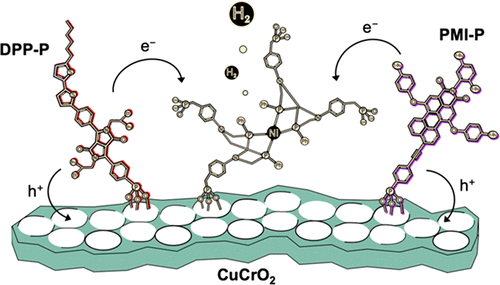当前位置:
X-MOL 学术
›
ACS Catal.
›
论文详情
Our official English website, www.x-mol.net, welcomes your
feedback! (Note: you will need to create a separate account there.)
Inverse Opal CuCrO2 Photocathodes for H2 Production Using Organic Dyes and a Molecular Ni Catalyst.
ACS Catalysis ( IF 11.3 ) Pub Date : 2019-09-09 , DOI: 10.1021/acscatal.9b02984 Charles E Creissen 1 , Julien Warnan 1 , Daniel Antón-García 1 , Yoann Farré 2 , Fabrice Odobel 2 , Erwin Reisner 1
ACS Catalysis ( IF 11.3 ) Pub Date : 2019-09-09 , DOI: 10.1021/acscatal.9b02984 Charles E Creissen 1 , Julien Warnan 1 , Daniel Antón-García 1 , Yoann Farré 2 , Fabrice Odobel 2 , Erwin Reisner 1
Affiliation

|
Dye-sensitized photoelectrochemical (DSPEC) cells are an emerging approach to producing solar fuels. The recent development of delafossite CuCrO2 as a p-type semiconductor has enabled H2 generation through the coassembly of catalyst and dye components. Here, we present a CuCrO2 electrode based on a high-surface-area inverse opal (IO) architecture with benchmark performance in DSPEC H2 generation. Coimmobilization of a phosphonated diketopyrrolopyrrole (DPP-P) or perylene monoimide (PMI-P) dye with a phosphonated molecular Ni catalyst (NiP) demonstrates the ability of IO-CuCrO2 to photogenerate H2. A positive photocurrent onset potential of approximately +0.8 V vs RHE was achieved with these photocathodes. The DPP-P-based photoelectrodes delivered photocurrents of -18 μA cm-2 and generated 160 ± 24 nmol of H2 cm-2, whereas the PMI-P-based photocathodes displayed higher photocurrents of -25 μA cm-2 and produced 215 ± 10 nmol of H2 cm-2 at 0.0 V vs RHE over the course of 2 h under visible light illumination (100 mW cm-2, AM 1.5G, λ > 420 nm, 25 °C). The high performance of the PMI-constructed system is attributed to the well-suited molecular structure and photophysical properties for p-type sensitization. These precious-metal-free photocathodes highlight the benefits of using bespoke IO-CuCrO2 electrodes as well as the important role of the molecular dye structure in DSPEC fuel synthesis.
中文翻译:

使用有机染料和分子 Ni 催化剂生产氢气的反蛋白石 CuCrO2 光电阴极。
染料敏化光电化学(DSPEC)电池是一种新兴的太阳能燃料生产方法。最近开发的铜铁矿 CuCrO2 作为 p 型半导体,可以通过催化剂和染料成分的共组装来产生氢气。在这里,我们提出了一种基于高表面积反蛋白石 (IO) 架构的 CuCrO2 电极,在 DSPEC H2 一代中具有基准性能。磷酸化二酮吡咯并吡咯 (DPP-P) 或苝单酰亚胺 (PMI-P) 染料与磷酸化分子 Ni 催化剂 (NiP) 的共固定化证明了 IO-CuCrO2 光生 H2 的能力。使用这些光电阴极实现了大约+0.8 V vs RHE 的正光电流起始电势。基于 DPP-P 的光电极提供 -18 μA cm-2 的光电流并产生 160 ± 24 nmol H2 cm-2,而基于 PMI-P 的光阴极表现出更高的 -25 μA cm-2 光电流并产生 215 ± 215 nmol H2 cm-2。在可见光照明(100 mW cm-2,AM 1.5G,λ > 420 nm,25 °C)下,2 小时内 10 nmol H2 cm-2,0.0 V vs RHE。PMI构建的系统的高性能归因于其非常适合p型敏化的分子结构和光物理性质。这些不含贵金属的光电阴极凸显了使用定制 IO-CuCrO2 电极的优势以及分子染料结构在 DSPEC 燃料合成中的重要作用。
更新日期:2019-09-25
中文翻译:

使用有机染料和分子 Ni 催化剂生产氢气的反蛋白石 CuCrO2 光电阴极。
染料敏化光电化学(DSPEC)电池是一种新兴的太阳能燃料生产方法。最近开发的铜铁矿 CuCrO2 作为 p 型半导体,可以通过催化剂和染料成分的共组装来产生氢气。在这里,我们提出了一种基于高表面积反蛋白石 (IO) 架构的 CuCrO2 电极,在 DSPEC H2 一代中具有基准性能。磷酸化二酮吡咯并吡咯 (DPP-P) 或苝单酰亚胺 (PMI-P) 染料与磷酸化分子 Ni 催化剂 (NiP) 的共固定化证明了 IO-CuCrO2 光生 H2 的能力。使用这些光电阴极实现了大约+0.8 V vs RHE 的正光电流起始电势。基于 DPP-P 的光电极提供 -18 μA cm-2 的光电流并产生 160 ± 24 nmol H2 cm-2,而基于 PMI-P 的光阴极表现出更高的 -25 μA cm-2 光电流并产生 215 ± 215 nmol H2 cm-2。在可见光照明(100 mW cm-2,AM 1.5G,λ > 420 nm,25 °C)下,2 小时内 10 nmol H2 cm-2,0.0 V vs RHE。PMI构建的系统的高性能归因于其非常适合p型敏化的分子结构和光物理性质。这些不含贵金属的光电阴极凸显了使用定制 IO-CuCrO2 电极的优势以及分子染料结构在 DSPEC 燃料合成中的重要作用。













































 京公网安备 11010802027423号
京公网安备 11010802027423号